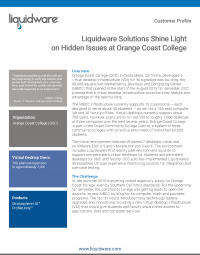VDI Testing with Liquidware Stratusphere UX Maintains Optimal Desktop Performance at OCC
Orange Coast College (OCC) developed a virtual desktop infrastructure for its signature new building, the 90,000 sq. ft. Mathematics, Business and Computing Center (MBCC) which opened with the fall semester, 2015. OCC is part of the Coast Community College District, a system of three community colleges that, together, serve more than 60,000 students. Plans are to roll out virtual desktops to roughly 7,000 concurrent users at three campuses over the next several years. OCC uses Liquidware solutions ProfileUnity and Stratusphere UX.
Stratusphere UX has been implemented for integration and use case testing as well as overall proactive monitoring of the sizeable virtual desktop environment. The solution was chosen as a result of OCC experiencing some serious issues in the course of the initial pilot of the VDI roll out. A major concern was that login times -- sometimes as high as 10 minutes -- were eating up classroom time and were totally unacceptable. OCC implemented ProfileUnity in order to cut down login times, which it did because staff could identify and remove unused services and remove unnecessary triggers. ProfileUnity was also leveraged to reduce profile bloat, (60 MB to 24 MB on average) and the overall desktop image size (80 GB to 50 GB), thus reducing the impact to storage.
But as much as ProfileUnity improved login times, it was still not enough to be in the acceptable range. A Liquidware engineer requested to run a Health Check Service with Stratusphere UX on the college's virtual desktop infrastructure. When he did, he uncovered a host of issues -- fortunately all of which could be addressed fairly easily. Among the issues that Stratusphere UX uncovered were:
- BIOS not configured uniformly on servers leading to uneven CPU Ready Times thus leading to performance issues of ESXi hosts
- Upgraded versions of hypervisor resulted in the need to upgrade resource capacity to support new version
- The storage configuration was causing IOPS bottlenecks
- An MS Office graphics accelerator feature was putting undue strain on system resources
- VMware AppVolumes was incorrectly configured.
Today, OCC does roll out ANY changes to their production desktop environment without first modeling the change in the test environment and measuring before and after performance with Stratusphere UX. In the final analysis from OCC, Liquidware solutions were the differentiator that allowed the college to get the maximum benefits and performance from their virtual desktops, thus enhancing learning for their sizeable and diverse student body.

